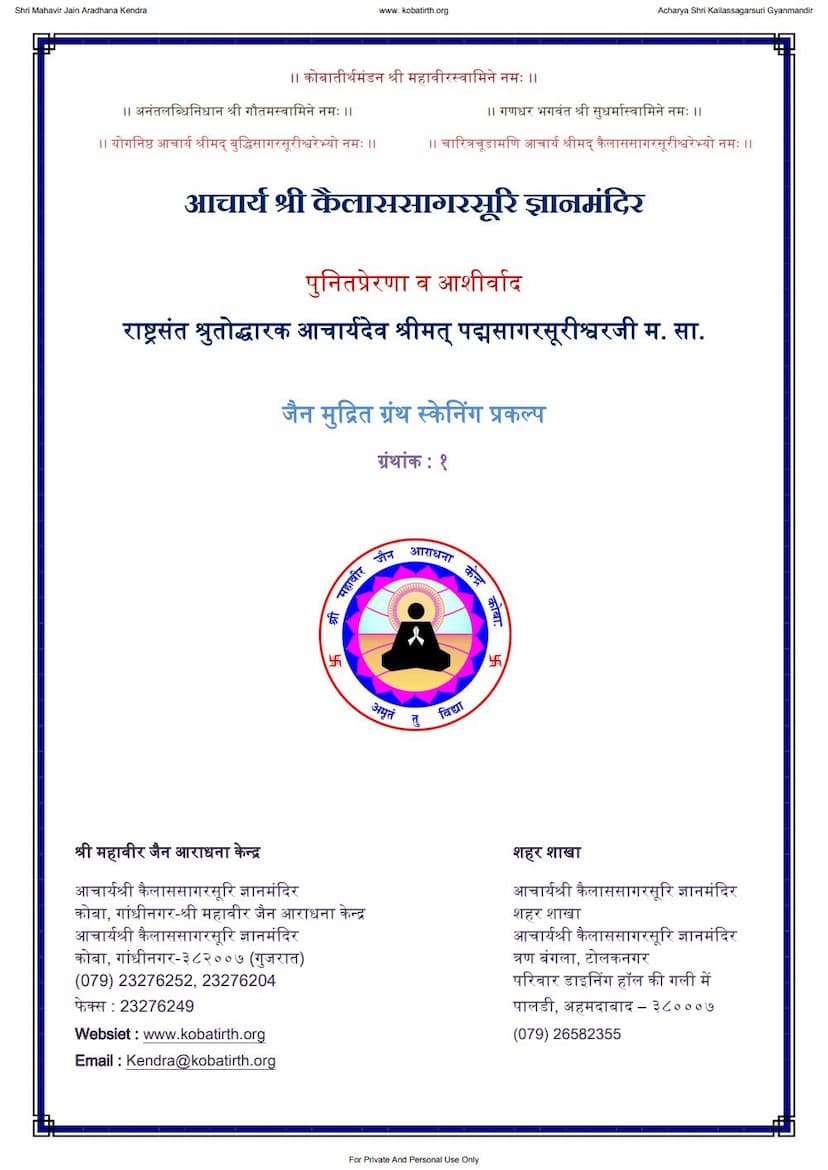Agam 32 Prakirnaka 09 Devendrastava Sutra Shwetambar
Added to library: September 1, 2025

Summary
This document is the scanned version of the Devendrastava Sutra, which is the 9th text in the Prakirnaka section (Agam 32) of the Shwetambar Jain canon. The text was compiled and edited by Acharya Shri Anandasagar Surishwarji Maharaj and the documentation work was spearheaded by Ganivarya Shri Purnachandrasagarji Maharaj. It was published by Jainanand Pustakalay.
The initial pages (1-5) contain introductory material, acknowledgments, and details about the publishing effort. These pages highlight the collaborative nature of the project, with many Acharyas and scholars contributing to its realization. It also mentions the Shri Mahavir Jain Aradhana Kendra and Acharya Shri Kailassagarsuri Gyanmandir as the institutions involved.
Pages 6-11 delve into the history of the Agamas (Jain scriptures) and the efforts made to preserve and codify them throughout different eras. This section details:
- The importance of Shrutgyan (knowledge gained through listening/scriptures) as a guiding light for beings wandering in the cycle of rebirth.
- The origin of the Agamas, attributed to the eleven Gandharas led by Gautam Swami immediately after Lord Mahavir's attainment of omniscience.
- The six major recensions (Vachanas) of the Agamas:
- First Vachana: In the time of Shri Bhadrabahuswami, due to a severe famine.
- Second Vachana: In Ujjain, during the reign of Emperor Samprati, under the guidance of Aryasuhasti.
- Third Vachana: In Pataliputra, by approximately 200 Jinakalpi ascetics, 300 Sthavirakalpi ascetics, 300 female ascetics, and a large number of lay followers, to re-establish the texts after persecution.
- Fourth Vachana: In Dashpur (Mandsaur), by Aryarakshit Suri, who organized the four Anuyogas (categories of scriptures) to ensure the longevity of the Agamas.
- Fifth Vachana: In Mathura and Valabhi, by Ascetics from North and South India respectively, to consolidate the Agamas amidst political turmoil.
- Sixth Vachana: In Valabhi (Saurashtra), by Acharyas like Devardhiganikshamak and Kalak Suri, who, with divine assistance, compiled the 84 Agamas onto palm leaves, marking a significant step in preserving them in written form.
- The eventual decline of the systematic study and preservation of Agamas after about 1000 years, leading to scarcity of texts.
- The revival efforts in the 20th century, particularly highlighting the immense contribution of Acharya Shri Anandasagar Surishwarji Maharaj, who, despite numerous challenges, diligently researched, edited, and published the Agamas, organizing large-scale recitations. His work laid the foundation for the current printed editions.
The subsequent pages (12-31) contain the actual text of the Devendrastava Sutra. This section is written in Prakrit and details the celestial beings (Devas) and their abodes within the Jain cosmology. It meticulously describes:
- The thirty-two types of celestial beings (Devas) known as Devendra, who are worshipped for their virtues.
- The various classes of celestial beings:
- Bhavanavasi Devas: Dwelling in palaces and cities, including Asuras, Nagakumars, Vidyutkumars, Vayukumars, Stanitkumars, Agnikumars, Di pakumars, and Udahakumars. The text describes their numbers, abodes, lifespans, and the specific realms they inhabit across different continents and oceans within the Jambudvipa and other regions.
- Vantantara Devas: Occupying the middle realm, consisting of various types like Pisachas, Bhutas, Yakshas, Rakshasas, Kinnaras, Kimpurushas, Mahoragas, and Gandharvas. The text details their abodes, lifespans, and subdivisions.
- Jyotisha Devas: Celestial beings associated with celestial bodies like the Sun, Moon, stars, and planets. Their movements, positions, sizes, and the calculations related to their cycles are described.
- Kalpavasi Devas: Devas residing in various heavens (Kalpas) above the earth, up to the Anuttara Saudharmakalpa. The text enumerates twelve such heavens and their respective rulers, their lifespans, the number of palaces within them, and their varying heights.
- Anuttara Devas: The highest class of celestial beings, residing in the Anuttara heavens, characterized by their supreme bliss and absence of worldly attachments. Their abodes, lifespans, and the nature of their existence are described.
- The physical characteristics of the celestial abodes: Describing the dimensions, colors, and jewel-encrusted structures of their palaces and cities.
- The classification of beings based on their karma and attachment: Differentiating between those who are born directly (Svayopapanna), those who are born through touch (Sparshaja), those born through form (Rupaja), those born through sound (Shabdaja), and those born through mind (Manasaja).
- The diet and sustenance of celestial beings, which varies according to their class and lifespan.
- The knowledge possessed by celestial beings, particularly their Ovadhi (clairvoyant knowledge), and how it varies.
- The journey and liberation of Siddhas: The text concludes by explaining where the liberated souls (Siddhas) reside, their form (non-corporeal), their infinite knowledge and perception, and their state of eternal bliss, free from all suffering, birth, old age, and death.
In essence, the Devendrastava Sutra is a comprehensive text that not only extols the virtues of celestial beings but also serves as a detailed guide to the Jain cosmology, its various realms, inhabitants, and the ultimate state of liberation. The introductory sections emphasize the critical importance of preserving and disseminating these ancient scriptures.